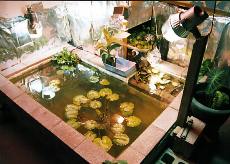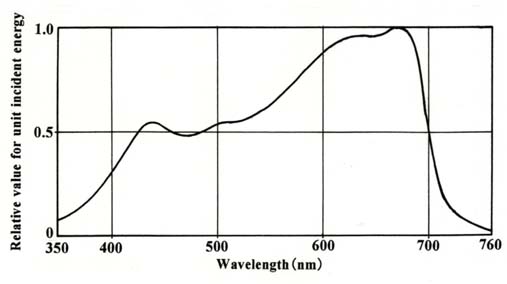
Lighting For Growing Plants Indoors
I collected the data for this article to further my own understanding about why relatively inexpensive MV lights were not suitable for indoor plant growth and this expanded into a cost/benefit analysis of the various HID lighting sources.
Mercury Vapour (MV) lights have 4 spectral peaks at 400nm, 440nm, 540nm and 580nm. The relative power is as follows: at 400nm power is 12% of output, at 440 its 20% of output, at 540 its 23% and at 580 its 27% of output. Based on charted data provided by Westinghouse.
The peak photosynthesis happens between 400 and 460nm (at about 80% photosynthetic activity) and at about 90-100% activity in the 640-700nm range. There is a lull in activity to about 40% in the 540-580nm range. Other studies have shown the 400-460 peak to be at 55% activity dropping slightly in the mid (green/yellow) region and then climbing steadily to the second peak at 100% in the 640-700nm range.

So as can be seen by combining the numbers MV produces virtually all of its output in the low efficiency area where photosynthetic activity is around 50%.
This means that while MV aren't "useless" for photosynthesis they certainly aren't the most effective choice, having most of their output in low efficiency regions. Combined efficiency calculations show that compared to a photosynthetically "IDEAL" light source (all the light is at the 100% activity peak) a MV bulb is only about 44% efficient. That is 56% of the light is "wasted" as non-productive in terms of plant growth. However when combined with the fact that MV lamps are less efficient at converting electricity to light to begin with, they seem like less of a deal than other HID type lights. From studies done by Iwasaki Electric Co. the overall Plant Growth Efficiency (PGRE) for MV bulbs ranges from 6-12% when considering conversion of electrical energy to plant growth energy. This is pretty low, but significantly better than incandescent bulbs which run at less than 2% efficiency at producing light, let alone in an effective spectra for plant growth.
Metal Hydride (MH) lamps produce similar spectral peaks in the blue (400-500nm) and yellow/green (500-600nm) ranges as MV lamps. Where they differ is they also produce significant light energy in the red (600-700nm) range where photosynthetic activity is strongest. Also MH lamps are significantly more efficient at converting electricity to light. The end result is, MH bulbs have plant growth efficiencies in the 18-20% range, quite a bit better than MV. (Data again from Iwasaki Electric Co.)
Finally we have High Pressure Sodium (HPS). HPS produces large amounts of light in both the yellow/green and red ranges, somewhere around 40% of its output in red, 50% in yellow/green and 10% in the blue. Also HPS have the highest conversion efficiencies, significantly higher even than MH. The overall Plant growth efficiency for HPS lamps runs quite high, from 25-33%.
The biggest problem with HPS is the large amount of vegetative growth with lanky stem formation induced by red light, so care must be taken when growing with HPS to balance it with adequate blue light. Also HPS lamps give very poor colour rendition if you want to be able to enjoy looking at your plants as well as growing them.
Finally there is the issue of cost, both in initial purchase and in operation.
MV cost $45 Cdn for a 175W unit with bulb.
Replacement bulbs are approx $15 with a 10,000 hr life.
At $0.08/kwh it costs $0.016 per hour to run including amortized bulb replacement,
and produces 10.5-21W useful growing energy.
*Sample calculations: (175/1000)*$0.08=$0.014
$15/10000=$0.0015
$0.014+$0.0015=$0.016 (with rounding up to nearest tenth of a
cent)
MH cost $219 Cdn for a 400W unit with bulb.
and $319 Cdn for a 1000W unit with bulb.
Replacement bulbs cost $45 for 400W, (5400hrs) and $120 (9000 hrs) for 1000W. For a 400W system it costs $0.040 per hour and produces 72-80W useful growing energy. For 1000W system it costs $0.093 per hour and produces 180-200W useful growing energy.HPS cost $219 Cdn for a 400W unit with bulb
and $319 Cdn for a 1000W unit with bulb
Replacement bulbs are approx $45 for 400W with 14,400 hr life and $120 for 1000W. For 400W it costs $0.035 per hour and produces 100-133W useful growing energy. For 1000W it costs $0.088 per hour and produces 250-330W of useful growing energy.
Summary:
MV 6-12% efficient for plant growth
MH 18-20% efficient for plant growth
HPS 25-33% efficient for plant growth
Costs including replacement bulbs for 180-200W of useful growing energy.
MV 175W requires 18 units: $810 initial cost, plus $0.29/hr
MH 400W requires 3 units: $657 initial cost, plus $0.12/hr
MH 1000W requires 1 unit: $319 initial cost, plus $0.09/hrHPS 400W requires 2 units: $438 initial cost, plus $0.07/hr
HPS 1000W requires 1 unit: $319 initial cost, plus $0.09/hr
Clearly higher wattage single units in MH or HPS are the most economical to buy AND use if you require high light densities. HPS is slightly more cost effective but has the downside that it really can't be used alone for most plants. For the cost of MV you could buy TWO 1000W units (say one HPS and one MH) and still have it cost less to run for more than DOUBLE the available energy for plant growth.
*NOTE: all prices are as of Sept 18, 2003 at local hardware and hydroponics stores, cost of operation based on 8 cents per kWh. All dollars in Canadian funds. The Iwasaki Electric Co. papers by Shinji Tazawa can be found online at: http://ss.jircas.affrc.go.jp/engpage/jarq/33-3/contents.htm
Building an Indoor Pond for the Budget Conscious